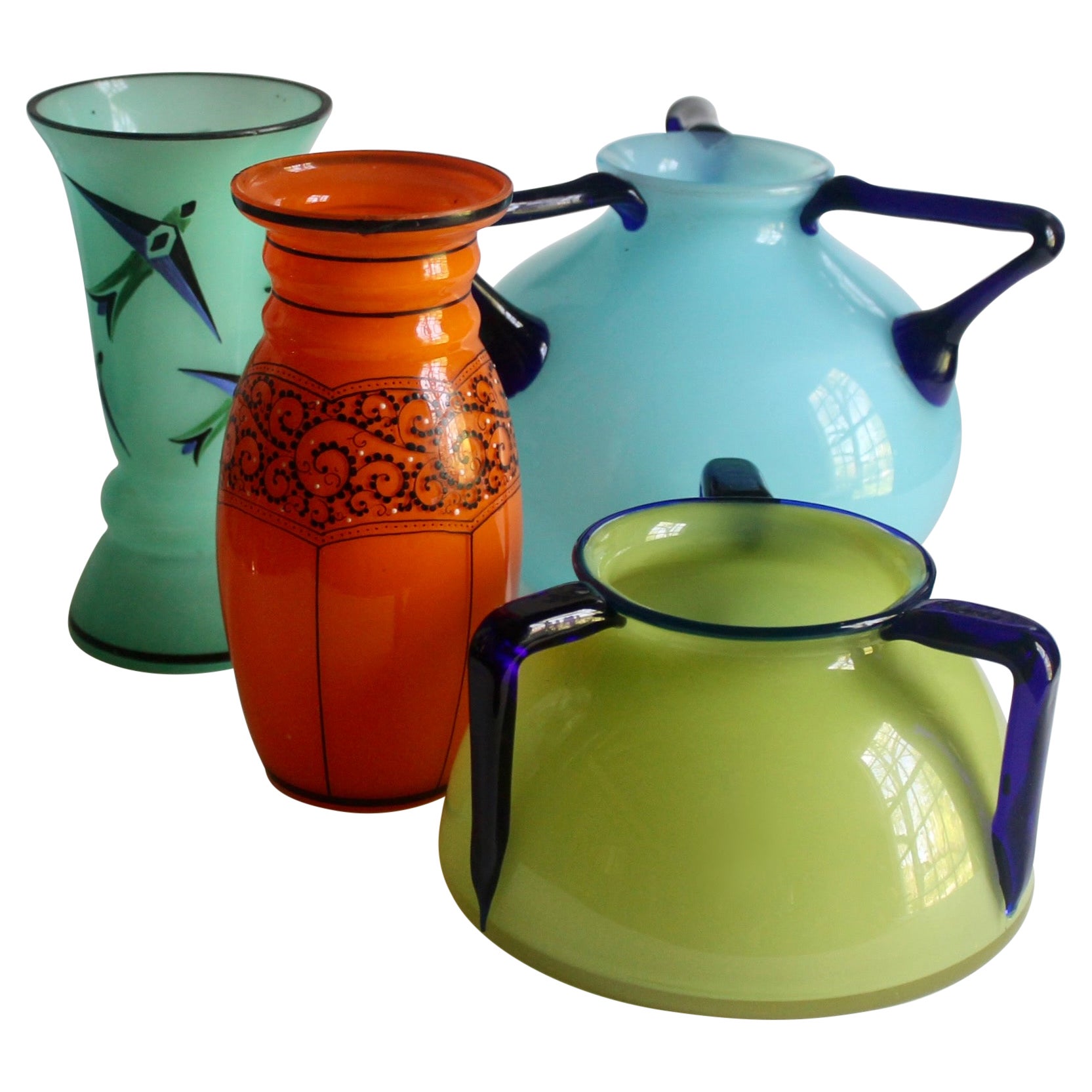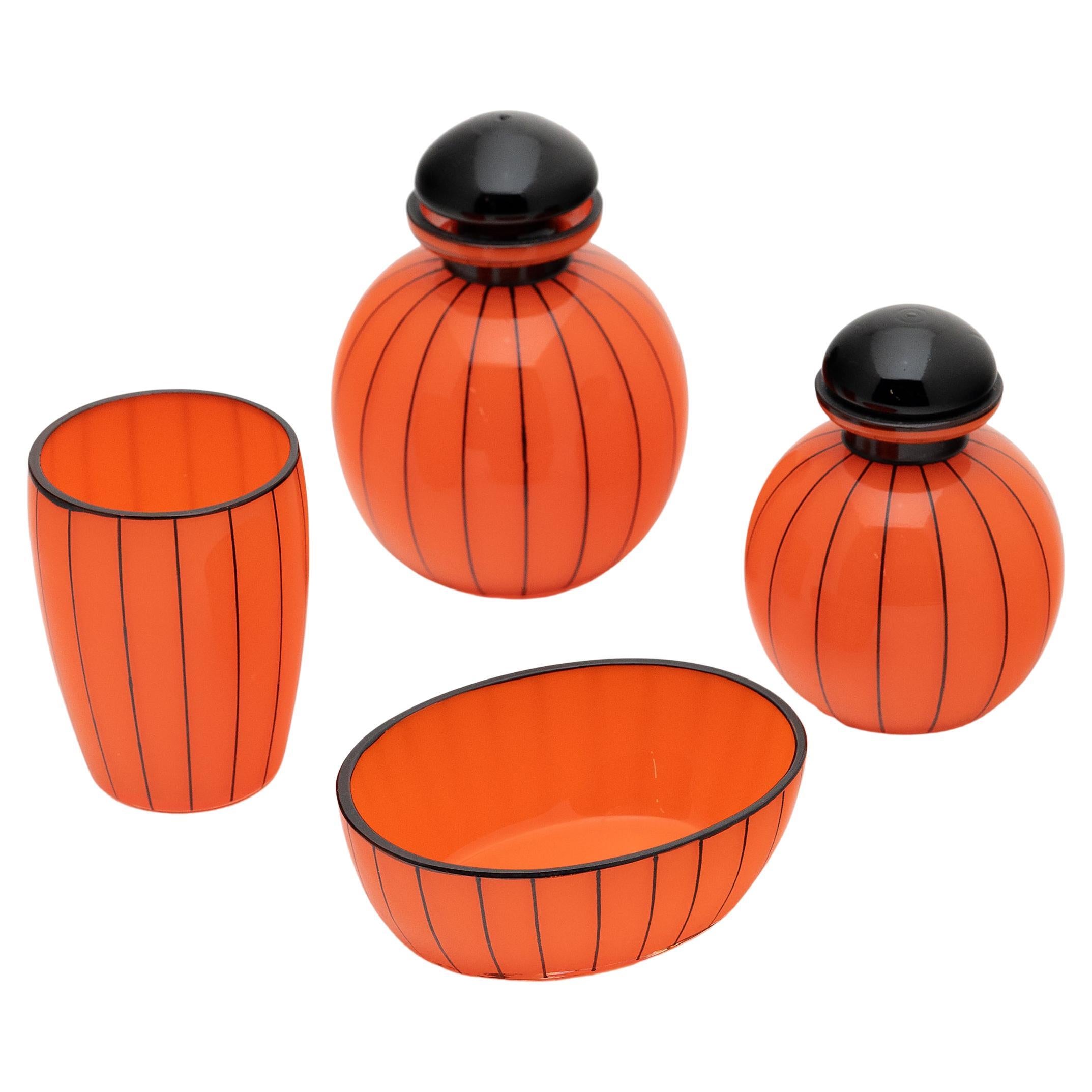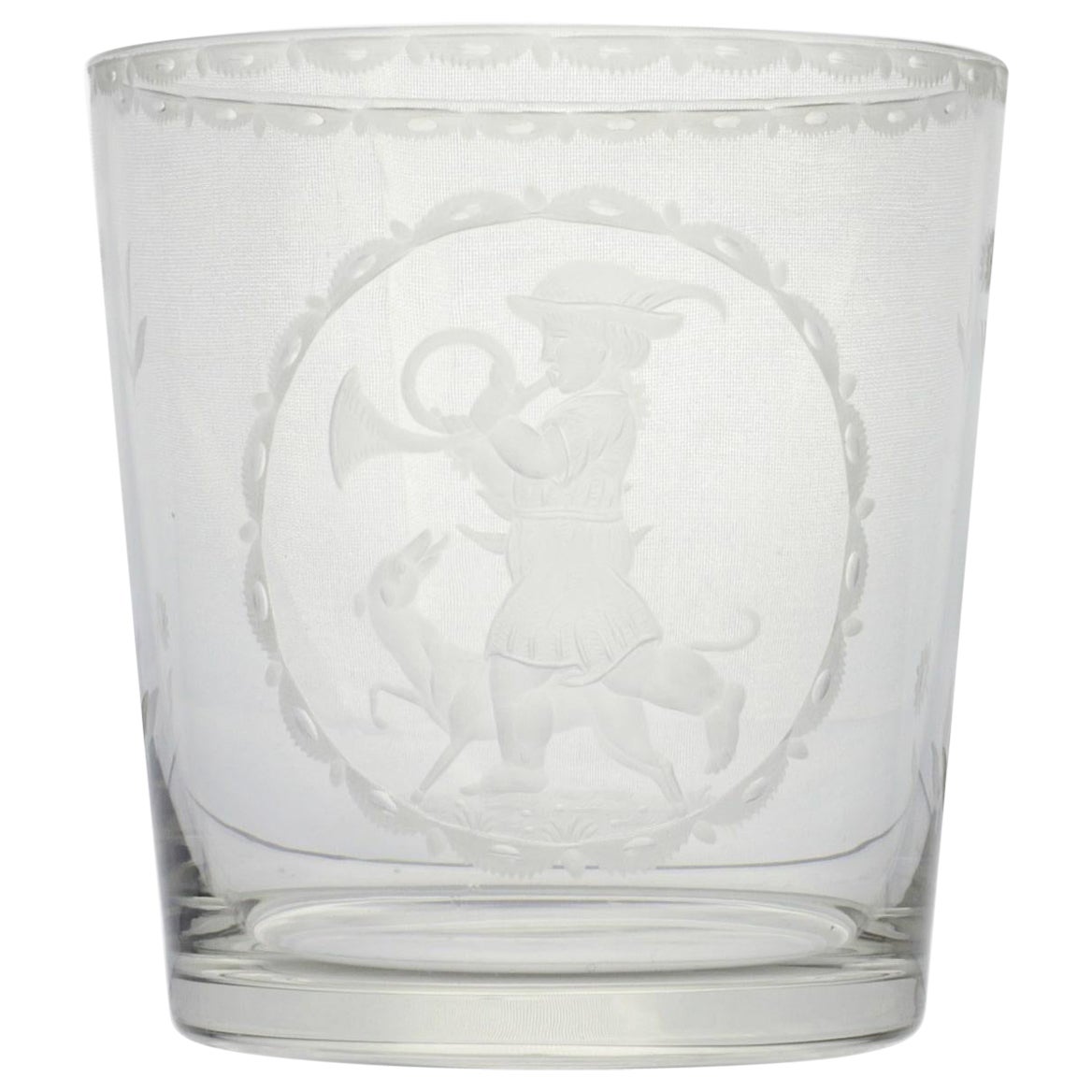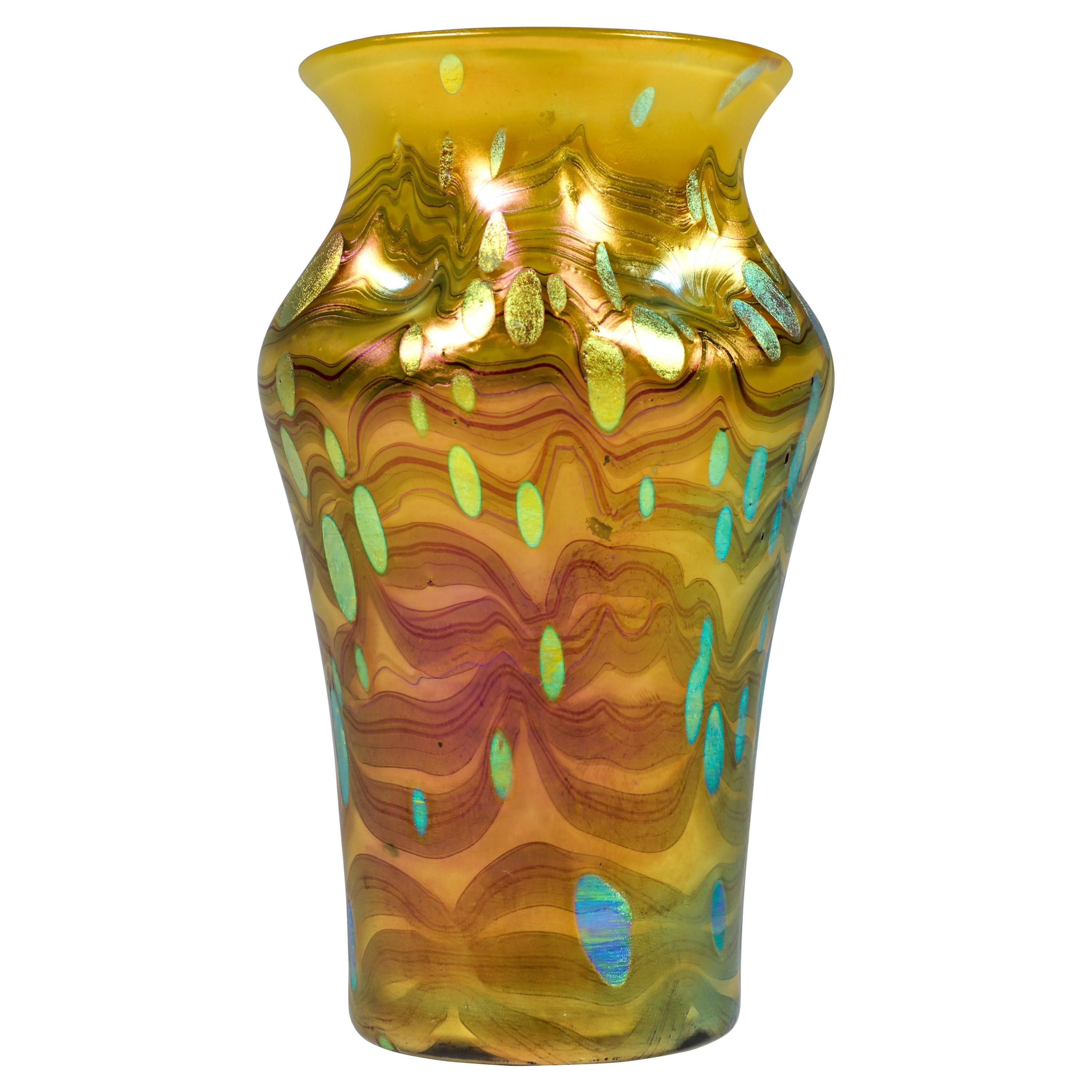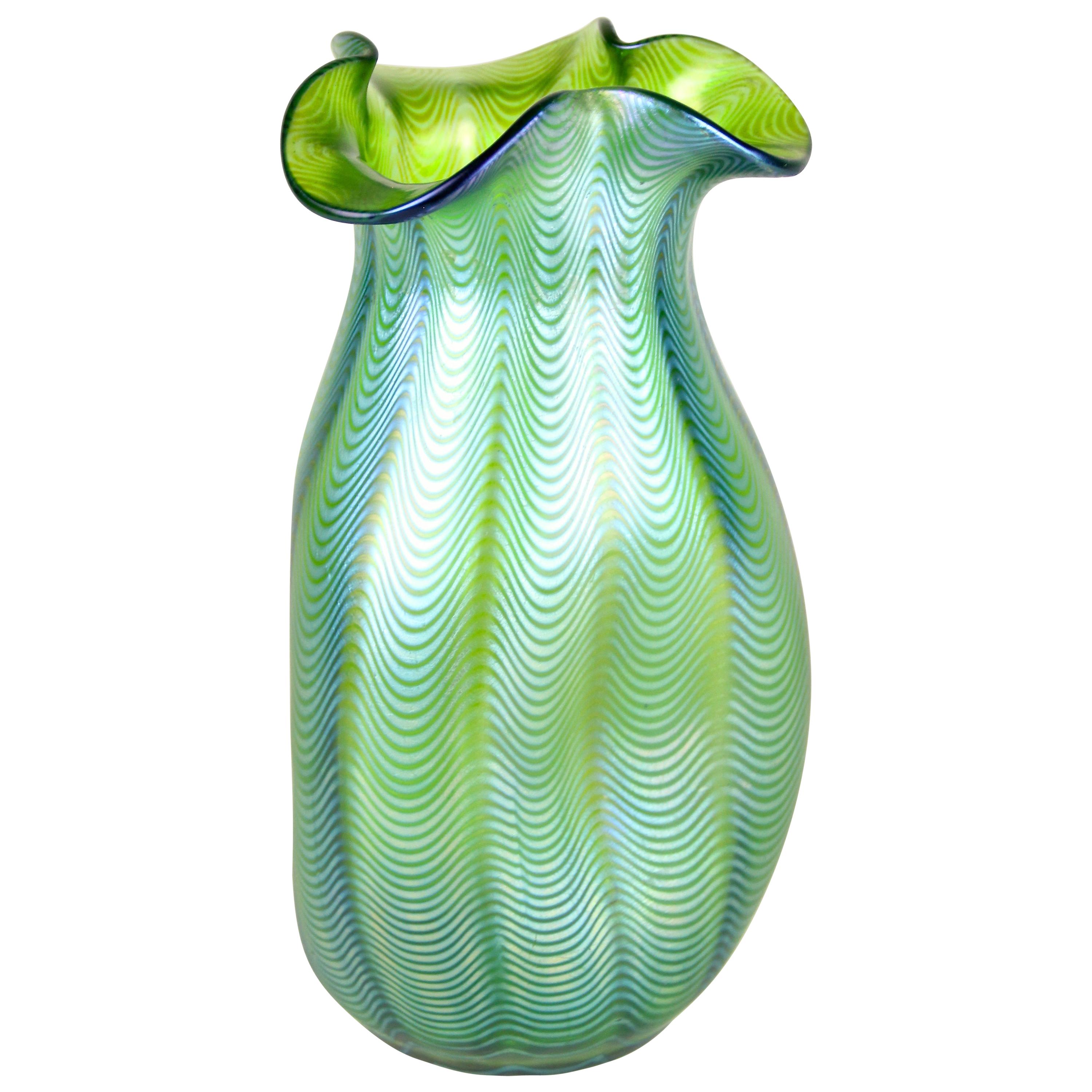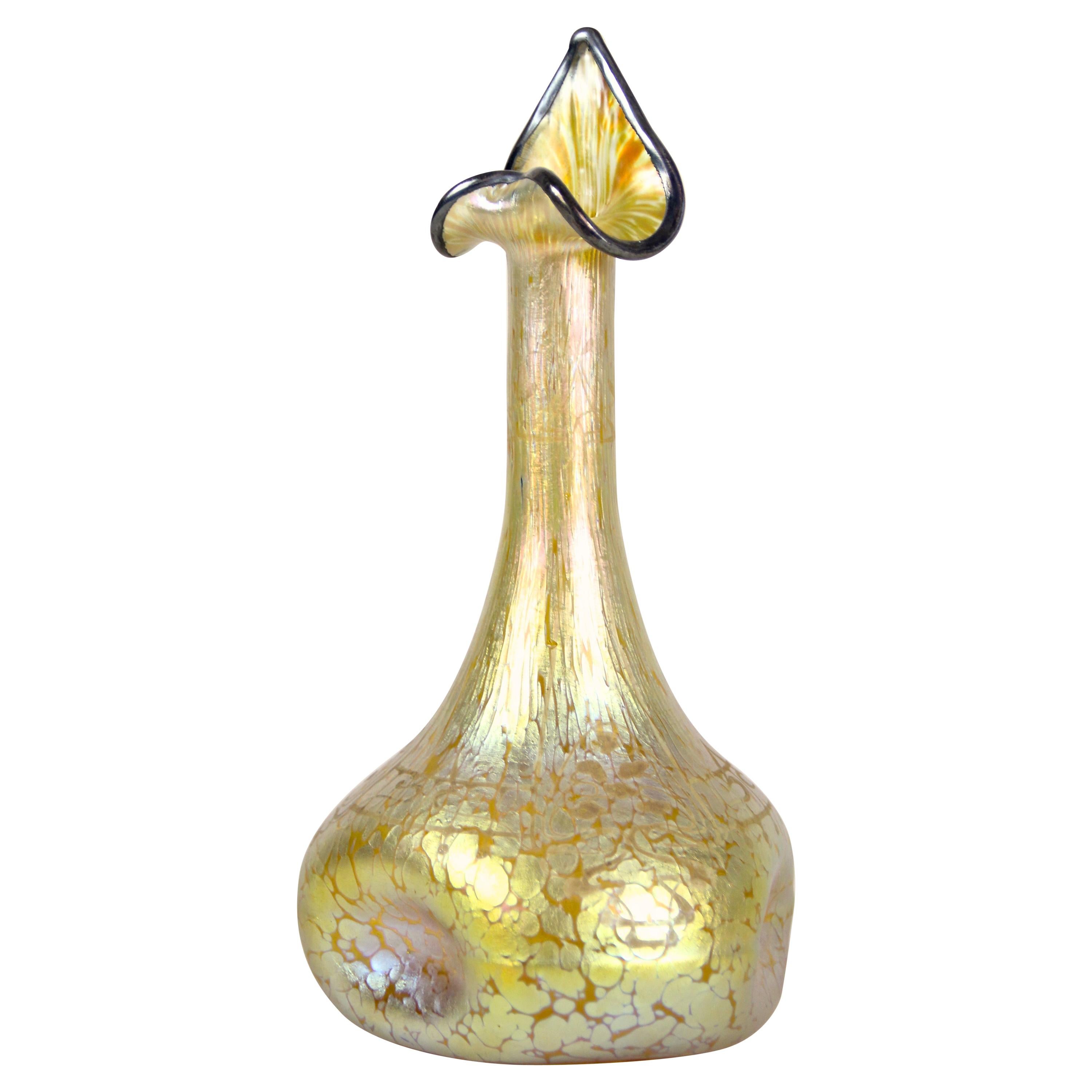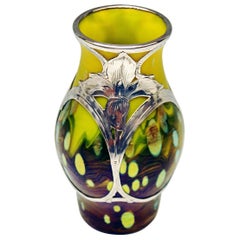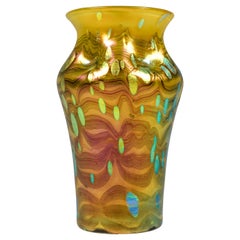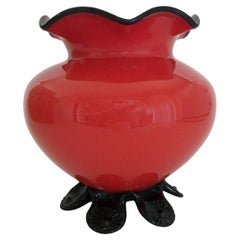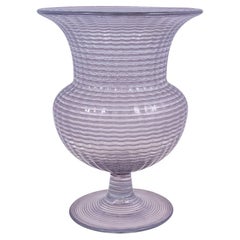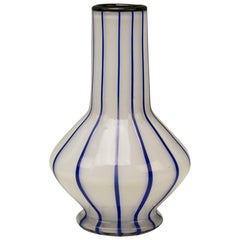
Tango Vase Michael Powolny Loetz Klostermühle Model 5231 Bohemia made 1915
View Similar Items
Tango Vase Michael Powolny Loetz Klostermühle Model 5231 Bohemia made 1915
About the Item
- Creator:Michael Powolny (Designer)
- Dimensions:Height: 7.48 in (19 cm)Diameter: 2.75 in (6.99 cm)
- Style:Art Nouveau (Of the Period)
- Materials and Techniques:
- Place of Origin:
- Period:1910-1919
- Date of Manufacture:circa 1915
- Condition:THERE AREN'T ANY DAMAGES EXISTING.
- Seller Location:Vienna, AT
- Reference Number:1stDibs: LU101446760873
Michael Powolny
As both a designer and a teacher, the Austrian ceramicist and glassware designer Michael Powolny was an important figure in the development of modernist aesthetics in Vienna at the turn of the 20th century. His romantic sculptural pottery figures embrace the lush, dynamic stylings of Gustav Klimt and other progressive artists, while his functional pieces — such as glass bowls and vases — employ the simple linear and geometric ornamentation that marked the work of Josef Hoffmann and other members of the Wiener Werkstätte community of designers and craftsmen.
Powolny received classical training in ceramics from his father, a potter, and at the Vienna School of Applied Arts, but later joined in the modernizing movement in the Austrian arts at the close of the 19th century. In 1897, Klimt, Hoffman, Koloman Moser and other artists and architects founded the Vienna Secession, a group that fought for freedom of expression against the city’s tradition-bound arts establishment. Powolny’s work reflects the changing times. He used classical figures in his ceramics — female nudes, cherubs — yet would dress them in modern ornament such as garlands of abstract, geometric flowers. Pieces from Powolny’s ceramics company were sold through the Wiener Werkstätte (Viennese Workshops) founded by Hoffmann and Moser, and Hoffman later hired Powolny to create ceramic ornamentation for his architectural masterpiece, the Palais Stoclet in Brussels.
Powolny would go on to design glassware that combines elegant, tapering forms with precise linear decoration. His most influential work may have come as a professor at the School of Applied Arts, where he taught both Lucie Rie, the great Austrian-British modernist ceramicist, and the American potter Viktor Schreckengost, creator of the “Jazz Bowl,” an icon of the Streamline Moderne design. As you will see from the items on offer, Michael Powolny’s works have a double appeal: in their sprightly, endearing forms and as artifacts that document a period of signal change in the history of modern arts and crafts.
- Vase Loetz Widow Klostermuehle Bohemia Art Nouveau Lemon Yellow CytisusBy Loetz GlassLocated in Vienna, ATVase Loetz (Lötz) Widow Klostermuehle Bohemia Art Nouveau Made by Loetz, Klostermuehle (Bohemia), circa 1902 Decor: Lemon Yellow Cytisus It is a very interesting Loetz Art N...Category
Antique Early 1900s Austrian Art Nouveau Glass
MaterialsGlass
- Loetz Art Nouveau Vase Metallic Yellow Cytisus, Bohemia around 1902By Loetz GlassLocated in Vienna, ATFinest Bohemian Art Nouveau glass vase in the form of a blown, baluster-shaped body with a neck pressed five times and a flared, flat rim of the mouth. Shape: Production number PN...Category
Antique Early 1900s Austrian Art Nouveau Glass
MaterialsGlass
- Vase Loetz Widow Klostermuehle Bohemia Art Nouveau Creta Pampas before 1902By Loetz GlassLocated in Vienna, ATVASE LOETZ (LÖTZ) WIDOW KLOSTERMUEHLE BOHEMIA ART NOUVEAU Made by Loetz, Klostermuehle (Bohemia), before 1902 Decor: CRETA PAMPAS BLUE-GREEN It is an elegant Loetz Art Nouveau ...Category
Antique Late 19th Century Austrian Art Nouveau Glass
MaterialsGlass
- Loetz Art Nouveau Vase, Decor Candia Papillon, Bohemia, Austria-Hungary 1898By Loetz GlassLocated in Vienna, ATFinest Bohemian Art Nouveau Glass Vase: Mould-blown glass vase, cylindrical lower body on a recessed, flush stand, long, slender neck with flared rim. Shape: Series I, Prod. nr. - P...Category
Antique 1890s Austrian Art Nouveau Glass
MaterialsGlass
- Vase Loetz Widow Klostermuehle Bohemia Art Nouveau Phaenomen Genre 6893 c.1900By Johann Lötz WitweLocated in Vienna, ATVase Loetz (Lötz) Widow Klostermuehle Bohemia Art Nouveau Made by Loetz, Klostermuehle (Bohemia), circa 1899-1900 Decor: RUBY PHAENOMEN GENRE 6893 It is a most remarkable as wel...Category
Antique 1890s Austrian Art Nouveau Glass
MaterialsGlass
- Loetz Art Nouveau Vase, Decor Candia Papillon, Bohemia, Austria-Hungary 1898By Loetz GlassLocated in Vienna, ATFinest Bohemian Art Nouveau Glass Vase: Mould blown glass on flush stand, bulbous raised body fourfold extensively impressed, with short wide neck, lip rim formed into quatrefoil, cu...Category
Antique 1890s Austrian Art Nouveau Glass
MaterialsGlass
- Michael Powolny - Loetz - Bohemian Red Tango Glass Vase - C.R., Early 20th CBy Michael Powolny, Loetz GlassLocated in Chatham, ONAntique Bohemian Jugendstil red Tango glass vase - possibly designed by Michael Powolny (1871-1954) and manufactured by Loetz - rare form with ruffled rim ...Category
Early 20th Century Czech Jugendstil Glass
MaterialsGlass
- Crystal Vase Jugendstil Austria circa 1918 Michael Powolny Loetz for LobmeyrBy Michael Powolny, Loetz GlassLocated in Klosterneuburg, ATThis elegant object of the Loetz glassworks was produced immediately after the First World War, in the years 1918- 1919. Although stylistic as well as technical recourse to past tech...Category
Vintage 1910s Austrian Jugendstil Vases
MaterialsGlass, Blown Glass, Art Glass
- Four Czech "Tango Glass" Vases Manner Michael Powolny and the Wiener WerkstatteBy Michael PowolnyLocated in Sharon, CTOffering a group of four very different Czech Tango vases. Blue handled vase: 5"height x 7" diameter. Green handled vase 3 1/4" x 5 3/4"diameter. Blue/gree...Category
Vintage 1920s Czech Art Deco Glass
MaterialsGlass
- Art Deco Orange Tango Glass Set by Michael Powolny for Loetz, c. 1920Located in Chicago, ILA collaboration between Austrian sculptor Michael Powolny (1871-1954) and art glass manufacturer Johann Loetz, this stunning vintage art glass set reflects Art Deco designs and perfe...Category
Early 20th Century European Art Deco Glass
MaterialsGlass
- Michael Powolny for Lobmeyr Etched Glass BeakerBy J.L Lobmeyr, Michael PowolnyLocated in Brisbane, QLDAn extremely fine glass beaker in a design by Michael Powolny (1871-1954) for Lobmeyr of Vienna. The piece retains its original fitted and labelled retailing box and has the makers m...Category
Early 20th Century Austrian Vienna Secession Glass
MaterialsGlass
- Vase Loetz , Style : Art Nouveau , Bohemia, circa 1900By Loetz GlassLocated in Ciudad Autónoma Buenos Aires, CLoetz The glass factory, originally founded in 1836 by Johann Baptist Eisner, was taken over. Loetz was the premier Bohemian glass works during this period. It was located in Klostermühle, near Rejštejn in the Sušice district in South-West Bohemia, which belonged to the Austro-Hungarian Empire until 1918. Susanna Loetz, widow of Glass entrepreneur Johann Loetz in 1852. She renamed the company "Glasfabrik Johann Loetz Witwe", a name that was retained until all activities were stopped in 1947. In 1879 it passed to Max Ritter von Spaun. Under his guidance, together with director Eduard Prochaska, the glassworks flourished as never before and enjoyed its most successful period. Von Spaun and Prochaska concentrated on the development of innovative glass types and new production techniques. Their first successful speciality was a glass type simulating semiprecious stones. It is often called "Marmoriertes Glas" ("marbled glass"). The range contained Onyx (red/brown), Karneol (red/pink) and later Malachit (green). It was introduced in the second half of the 1880's. From the same period dates the Octopus glass, of which the decor resembles the tentacles of a cephalopod. The production of Marmorier-tes Glas was resumed in 1906, in different colours like yellow and white. Octopus, 1885-1890, 1885-1890, unknown, an Malachit, 1885-1890, unknown, The master glass-blowers of Klostermühle had already carried out experiments with iridescence in the first half of the 1890's, and they produced the Olympia, a classically inspired olive green type, in 1896. Similar, in variants of creta green, bronce or Olympia and averse to any redundant decoration was the Glatt decor. It highly contrasted with the more elaborate finishes of that time, but it constitutes a part of the production with a deep sense for taste and quality. Most of the pieces shown in the "Glatt" decors were manufactured for Max Emmanuel in London. The glatt decor remained in use for many years. The Chiné decor had thin glass threads spun around the body in irregular patterns. It is not to be confused with the type of glass that was produced by Kralik. Loetz "Chiné" came in clear, opal, green and pink, Kralik "Chiné" in dark purple. The logical sequel to Chiné was the Pampas decor, green or cobalt blue, in which the threads almost disappeared in the surface, with iridised parts in between. Around the same time the dotted Papillon decor was introduced. The beautiful silver spots were employed on a wide array of models and quite effective on the gooseneck (water sprinkler) and sea shell...Category
Antique Early 1900s Austrian Art Nouveau Glass
MaterialsArt Glass


